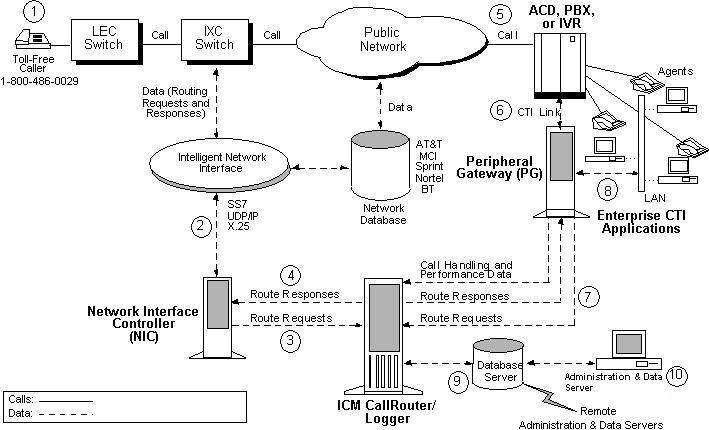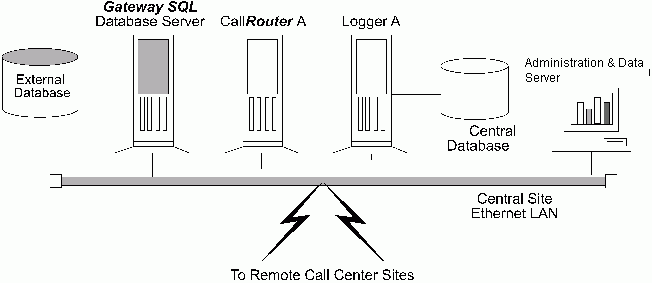How Unified ICME Software Works
The Unified ICME Edition works with your contact center equipment and the IXC carrier network to create a virtual contact center. In the virtual contact center model, multiple distributed contact centers link to form one Unified CCE. The agents within the Unified CCE become members of a single team that is capable of servicing customer contacts throughout the enterprise.
Unified ICM Call Routing
The Unified ICM software makes the best use of your contact handling resources while ensuring that each customer is directed to the most appropriate resource available. To get an idea of how the Unified ICM software fits into the contact center and carrier environments, refer the following sections. These sections examine how the Unified ICM software routes telephone calls.

Pre-routing
The Unified ICM software executes call routing decisions before a call terminates at a contact center. This concept is called pre-routing. As shown in the preceding figure, calls to be routed usually originate in the public telephone network as calls to a toll-free number (1).
The IXC Network
The Unified ICM software is configured in the intelligent network of the IntereXchange Carrier (IXC) to receive a route request for each designated incoming call (2). A subsystem of the Unified ICM software, called the Network Interface Controller (NIC), communicates with the carrier's network through an intelligent network interface.
Route Requests
The NIC translates the network's description of the call, including point of origin, number dialed, and any customer entered digits, into the language of the Unified ICM software. The NIC passes this call information to the CallRouter in the form of a route request (3).
 Note |
Figures usually show the NIC as a separate computer. Actually, NICs are implemented as software on the Unified ICM software platform (usually on the CallRouter or CallRouter/Logger [Rogger] machines). |
Route Responses
At this point, the Unified ICM software may query an ANI or customer profile database before returning a route response to the NIC (4). The NIC passes a destination for the call back to the IXC network. The IXC connects the call and maintains the voice path.
ACDs
Each contact center has one or more Automatic Call Distributor (ACD) systems that direct incoming calls to the telephone sets of individual agents (5). The Unified ICM software maintains real-time communications with the ACDs in each contact center by using a Peripheral Gateway (PG).
Peripheral Gateway
The PG communicates with the ACD over the switch vendor Computer Telephony Integration (CTI) link (6). To make optimal decisions, the Unified ICM software must know the latest status for every call, agent, and agent group in its network. One purpose of the PG is to extract this status information from the ACD and forward it to the CallRouter in-memory database. You can also use the PG as a CTI Server and as a communications interface between the Unified ICM and Voice Response Unit (VRU) systems located at contact center sites or in the network.
Post-routing
In private network configurations, ACDs can also originate call routing requests. This is called post-routing. Post-routing provides the same intelligence used in pre-Routing, but applies it to calls originating from a private network of ACD, PBX, and VRU systems. The PG assists in post-routing by forwarding routing requests to the Unified ICM software and returning the target destinations to the ACD (7).
CTI Server
External server or workstation applications can subscribe with a PG that acts as a CTI Server (8). The CTI Server provides call and agent event data that can be used in screen-pops and other CTI applications. At the desktop level, the Unified ICM CTI desktop provides an environment for integrating soft-phone, screen-pop, and data entry at the agent's workstation.
Monitoring and Reporting
All event data that the PG and router gathers is forwarded to the Unified ICM software and stored in an industry-standard relational database (9). This data is used in real-time monitoring and historical reporting. You can modify the standard Unified ICM monitoring screens and reports with Unified ICM-provided database access tools. Optionally, you can access the data directly with SQL or Open Database Connectivity (ODBC) tools.
Administration & Data Server
An Administration & Data Server (10) monitors and controls the overall operation of the Unified ICM software. The Unified ICM software can support multiple Administration & Data Servers located throughout the contact center network.

 Feedback
Feedback